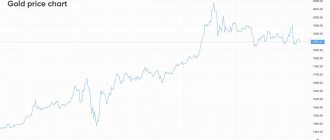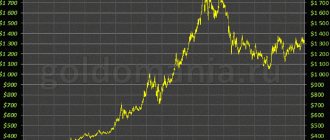Why don’t I have gold in my portfolio under the “Million from Scratch” section?
I often come across similar questions and recommendations from readers to add gold ETFs. Below I will tell you about my reasons for not including gold in the “children’s portfolio”.
A bit of poetry. Throughout my “short investing life,” my attitude towards gold has changed several times. From delight (and serious earnings) to disappointment and indifference. As a result, I developed a certain position regarding investing in gold. Which I want to share with you below, diluting my thoughts with graphs, pictures and statistics.
So, let's go!
Factors against gold
Low yield
What kind of return can a long-term investor expect? Usually the average value is taken based on historical data over many years. Many years is not one or two decades, but much more.
And what do we have for gold?
The real historical return (above inflation) of gold over the past 100 years is 1.68% per annum.
Is it a lot or a little? You need to compare with other asset classes over the same period:
- The shares yielded 7.09% per annum;
- The bonds yielded an average of 2.29% per year.
It turns out that the average return on gold is lower than stocks and bonds. By investing part of the money in gold, we reduce the profitability of the portfolio.
What does this mean for an investor?
Over long periods, even a small decrease in expected profitability can greatly affect the final result. An investor may lose hundreds of thousands and even millions (literally).
Quick example.
We invest 100,000 per year for 20 years at 7% per annum.
A decrease in yield of just 1% leads to a non-receipt (loss) of 500,000 at the end of the investment period.
High volatility
In addition to “naked profitability,” you need to take into account the risk (volatility) of the instrument. Volatility measures how much returns are likely to deviate from historical average returns (either up or down).
Historical volatility of instruments:
- Bonds - 6.5%;
- Gold - 16%;
- Shares - 18.8%.
As a result, we find that gold has:
- the risk level is more than 2 times higher than bonds, with lower returns;
- comparable risk to stocks, but losing several times in profitability.
Plateau periods
Did you know that there was a period in the history of gold when quotes were in decline for several decades? Literally.
Since 1980, having reached their peak, quotes have gone into a long correction. And prices returned to the previous level (in 1980) only after 27 years.
Someone is afraid of surviving a 30-40% collapse in the stock market. And I would be scared to be in a drawdown for 27 years. Would I like this? Absolutely not.
27 years are still young. In fact, taking into account the real value of money (adjusted for inflation), 1980 prices were never reached. Investors who bought gold 4 decades ago are still in the red.
The graph below shows the growth of $1 invested in gold.
- blue line - nominal value now;
- yellow - real cost (above inflation).
Gold yield: real and nominal
As can be seen from the graph, current quotes are not even close to the previous peak of 2011 (again, a decade in drawdown).
Just metal
When we invest money in shares, we receive benefits (profits) from the operation of the business. The company produces and sells something. The income is invested in the development (increase) of the business. Or pays out in the form of dividends.
Bonds provide coupon income. Borrowed money brings in extra money.
In other words, these assets have added value.
What about gold? Nothing. Just as you have a kilogram (half a kilo, 5-10 grams) in your hands now, so it will remain in 5-10 and even 100 years.
Warren Buffett put it very clearly on this matter:
...gold is dug out of the ground...Then we melt it down, dig another hole, bury it again and pay people to stand around and guard it. Gold has no use. Any observer from Mars would scratch his head if he saw all this nonsense...
Another graph.
1 dollar invested in the early 70s of the last century brought the investor:
- in the S&P500 index (including reinvestment of dividends) - $24.52;
- in gold - $1.98.
How and why to buy gold
Learning how to buy gold is worthwhile, as the precious metal is very important from a financial point of view. At any given time, gold can become a so-called “safe haven” for you, insurance against inflation and the collapse of the country’s economy, as well as an excellent way to diversify assets.
Why buy gold
Gold can add real shine to your investment portfolio, and here's why.
· It is extremely rare. According to the commodities industry, gold makes up five parts per billion of the entire earth's crust, which is why it is so difficult to find and mine.
· There will be no less gold. It does not lose its quality and never changes structurally.
· The amount of gold is limited. All the gold deposits on earth could easily fit within the confines of Yankee Stadium.
· Many uses and forms. Gold comes in many shapes and sizes and can be made into many different types of finished products, including rings, bracelets, coins and other luxury items.
· It is difficult to find. Mining gold is risky, difficult and expensive. Thus, there is a lot of demand, but the supply is usually quite limited.
While the general reasons for buying gold have been listed above, there are more unique and personal reasons for purchasing this precious metal.
Read:
These 7 Stocks Are Expecting a Rally After Falling
Some make money from changes in the value of gold. Investors buy it when precious metal prices fall, knowing that they will rise again over time.
Others want to protect themselves from risks. Gold is significantly less volatile than other assets and equity indices. This way, investors reduce the overall risk of their investment portfolio. After all, gold always has value to someone, and in times of trouble you can sell it for a good price, even during an economic crisis (gold was in high demand in late 2008 and early 2009 when the US banking system was close to to collapse).
When to buy gold
The first step in buying gold is choosing the right time. At this stage, you need to be patient and monitor the markets closely. Just like with stocks, the idea of investing in gold is to buy it low and sell it high. Typically, precious metal prices decline when the stock market is rising and the economy is strong.
Gold is a commodity that can be used when the economy is doing poorly. So it is important to have time to buy it at the very beginning of the market decline, and not three months later.
You should also understand how gold is valued before purchasing it directly.
Gold is an extremely volatile commodity, with prices constantly rising and falling. To understand when to buy, check the “spot price,” which reflects the average supply price for gold as listed on global exchanges.
The spot price of gold can change significantly when global events occur, such as economic downturns, natural disasters, military conflicts, and changes in central bank forecasts, both for good and bad. When you buy gold, you will have to pay a commission (about 7% above the spot price), but you will be selling at the exact spot price.
What's the best way to buy gold?
If you're buying gold directly, first do your research to ensure you get a good deal. Use the following tips:
1. Find the best price
You can save money if you take the time to research the price range. Check out offers on dealer websites and gold exchanges, which are also easy to find online.
2. Exercise caution
Gold dealers are generally reliable sources for buying and selling the valuable metal, but it still pays to be vigilant. Be especially careful if you buy gold and decide to sell it to the same dealer.
Read:
Top 20 brokers – summing up the results of the winter
Some gold traders charge redemption fees and some do not. Check this out before attempting to sell your gold back to the same dealer. The lack of payment fees should be a decisive factor, since you can always sell the metal to another buyer and thus avoid unnecessary expenses.
3. Check the reliability of the seller
The United States Mint is an excellent resource for checking the reliability of gold dealers. Visit the seller page on the United States Mint website.
4. Beware of scams
Places not to buy gold include pawn shops, online sellers who entice customers with huge discounts, traders who advertise their services on television and promise "lowest prices", and any seller who charges a fee to store your gold. It is better to store gold yourself, either in your home or in a bank safe.
How to invest in gold
You can buy gold from a specific seller or exchange, but in this case there is a possibility that you will face the risks of fraud from your counterparty or the costs associated with storing your gold safely. In addition, when purchasing, you will have to pay a commission that is higher than the spot price.
If you don't want to face such problems, invest in gold instead of buying it directly. Use the following strategies.
1. “Golden” shares
You can purchase shares of companies that are engaged in gold mining and development of valuable metal deposits. This way, you will avoid the fees you would pay if you bought gold directly, and you won't have to pay for storage. In addition, the value of your shares will increase over time.
2. “Golden” funds
One of the most common ways to invest in gold is through gold ETFs. These are modern financial instruments that allow you to trade on the stock exchange shares of a single gold fund, backed by physical gold stored in bullion in banks.
Read:
We are starting a competition “MacBook for an accurate forecast of the price of Apple shares”
The world's largest gold ETF is SPDR Gold Shares, which was created in 2004 with the participation of the World Gold Council, which includes representatives of the largest gold mining companies in the world. Popular funds also include the GraniteShares Gold Trust. There are ETFs for gold on the Moscow Exchange.
3. Gold futures
Although buying and selling gold futures on, for example, the Chicago Mercantile Exchange is complex and risky, investors still have the opportunity. Just know that buying gold through commodity futures requires advanced skills that most beginners don't have. Here you can add the purchase of settlement futures for gold on the Moscow Exchange.
Six reasons to buy gold
Inflation protection
· Currency fall protection
· Insurance against geopolitical and financial market instability
· Investment based on supply and demand fundamentals
· Storage medium
· A way to diversify your investment portfolio
All of the above are good reasons to buy gold. First of all, you buy this metal as insurance against a downturn in the economy. Gold will protect you during times of instability, and its value can increase over time, making your investment even more valuable.
The beginning of the "golden" game
As with any investment, the outcome is largely determined by your preparation and awareness before making a trade, as well as the diligence required to monitor your gold investment in an often volatile commodity market.
If you are confident in your knowledge, don't be afraid to take action. Owning gold will diversify your portfolio and protect you from risks if the economic situation in the country becomes unstable.
Dollars
Oh, that dollar! How much shock it has brought to Russians over the past few years. And we bought it frantically with our last blood, and ran headlong to sell it as soon as it jumped from the heights.
It’s impossible to count how many nerves were spent, how many kitchen disputes were caused.
And all because the dollar was and remains the main reserve currency of the world. And this is not even due to the fact that the United States is the largest economy in the world.
The fact is that the largest number of foreign trade transactions are carried out in dollars, and US banks store the majority of government foreign exchange reserves (including those of such a giant as China).
The whole world, one way or another, is interested in maintaining the dollar exchange rate. The exchange rate may fluctuate, but in general the American currency is indestructible in the medium term.
Taking into account the ease of exchange, dollars are undoubtedly the most convenient “paper” money for savings.
The best proof of this is a comparison of the dollar with the second most important reserve currency, the euro. The EUR/USD ratio has changed over the past 10 years from approximately 1.35 to 1.1.
Those who bet on the dollar did not lose. Unfortunately, there is nothing to say about the ruble exchange rate. It devalues against the dollar with sad frequency.
What is money
It seems that everything is clear, that it’s simpler, money – pieces of paper and coins, for which you can buy almost everything. But not everything is so simple. Remember your social studies classes at school?
They also talked about money, you simply forgot. So, the most classic, basic definition of money is “universal equivalent.”
Money is also a commodity (yes, yes!), but it is a commodity that can be quickly and guaranteed exchanged for any other without spending any effort.
They have high liquidity, so it is customary to keep savings in money: when accumulating objects, livestock or any raw materials, you cannot be sure that the market situation will allow you to sell it at any time.
Money is another matter. Different types of money correspond to the concept of “universal equivalent” in different ways.
A classic example is USSR rubles. Formally, they had a very high value, but in fact it was possible to buy something with them only in the meager retail system of the socialist state or on the black market.
When evaluating different types of money, you need to pay attention to their level of convertibility.
Keeping all this in mind, let's try to evaluate several of the world's most famous "currencies" from the point of view of an ordinary citizen deciding how to keep his savings.
How much can you earn with US dollars?
✓In the summer of 2010, about 30 rubles were given for 1 American dollar.
100,000 rubles could buy 3,333 US dollars.
✓In the summer of 2021, they are asking about 70 rubles for 1 American dollar.
Accordingly, the $3,333 you bought 10 years ago could be sold today for 233,000 rubles.
✓The benefit would be 133,000 rubles.
What cannot be considered an investment in gold
Gold jewelry
Buying jewelry is not an investment at all.
The price includes the work of the jeweler, which sometimes reaches 80% of the cost of the product. And they will buy them from you at a price per gram. So you need to buy earrings and bracelets not to save capital, but for the soul.
Igor Fainman
An exception may be rare collectible jewelry, but you will not find them in a regular jewelry store.
Options and futures
These derivatives have little to do with investing in gold. Rather, we are talking about speculation related to the price of this precious metal. Due to this, they can bring increased profitability, but they also entail increased risks.
Such instruments are suitable only for experienced investors. If you are just starting to invest and someone offers you one of these options, then before agreeing, you should study the issue as carefully as possible.











